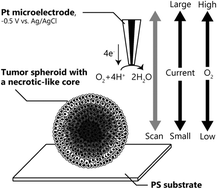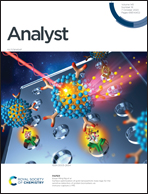Oxygen consumption rate of tumour spheroids during necrotic-like core formation†
Abstract
Hypoxia is one of the major hallmarks of solid tumours and is associated with the poor prognosis of various cancers. A multicellular aggregate, termed a spheroid, has been used as a tumour model with a necrotic-like core for more than 45 years. Oxygen metabolism in spheroids has been studied using phosphorescence quenching and oxygen-sensitive electrodes. However, these conventional methods require chemical labelling and physical insertion of the electrode into each spheroid, which may be functionally and structurally disruptive. Scanning electrochemical microscopy (SECM) can non-invasively analyse oxygen metabolism. Here, we used SECM to investigate whether the changes of the internal structure of spheroids affect the oxygen metabolism. We investigated the oxygen consumption rate (OCR) of MCF-7 breast tumour spheroids with and without a necrotic-like core. A numerical simulation was used to describe a method for estimating the OCR of spheroids that settled at the bottom of the conventional culture plates. The OCR per spheroid volume decreased with increasing spheroid radius, indicating the limitation of the oxygen supply to the core of the MCF-7 spheroid. Formation of the necrotic-like core did not affect the oxygen metabolism significantly, implying that the core had minimal contribution to the OCR even before necrosis occurred. OCR analysis using SECM non-invasively monitors the change of oxygen metabolism in tumour spheroids. The approach is promising to evaluate various three-dimensional culture models.



 Please wait while we load your content...
Please wait while we load your content...